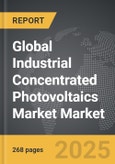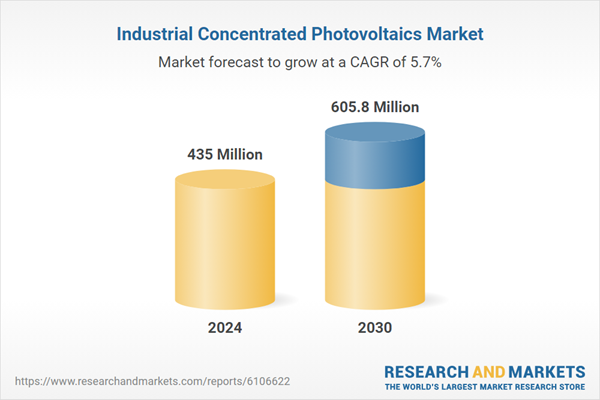Global Industrial Concentrated Photovoltaics Market - Key Trends & Drivers Summarized
How Is Industrial Concentrated Photovoltaics Transforming the Global Energy Equation?
Industrial Concentrated Photovoltaics (CPV) is rapidly redefining the landscape of solar energy by offering an innovative approach to power generation tailored for industrial-scale needs. Unlike conventional flat-panel photovoltaics, CPV utilizes precision optics such as Fresnel lenses or curved mirrors to concentrate sunlight onto ultra-high-efficiency multi-junction solar cells. This technique magnifies the solar input, enabling higher power generation per unit area and making it especially effective in areas with high direct normal irradiance (DNI). These include sunbelt regions such as the Middle East, Northern Africa, Australia, and the southwestern United States. For industrial stakeholders operating in these geographies, CPV represents an efficient use of land and capital investment, especially where land availability is constrained or environmental sensitivities must be respected. CPV systems are often paired with dual-axis tracking technology, allowing continuous alignment with the sun's trajectory and ensuring optimal exposure throughout daylight hours. This results in higher and more consistent energy yields than fixed-tilt or single-axis conventional PV setups. From an engineering perspective, the design and material quality of CPV systems are tailored for durability in harsh environmental conditions, further solidifying its attractiveness for remote or high-load industrial facilities. This includes remote mining operations, oil and gas installations, military outposts, and large-scale data centers, where uninterrupted power is critical. The convergence of these factors is enabling CPV to play a foundational role in the next phase of industrial decarbonization.Why Is the Technology Gaining Momentum in Utility and Industrial Circles?
Momentum behind industrial CPV adoption is accelerating as new efficiencies and applications are realized across global markets. One of the primary catalysts is the advancement in multi-junction solar cells, now achieving conversion efficiencies exceeding 40%, compared to the 20-23% typical of traditional silicon-based PV panels. This leap in performance translates to more energy generated from the same footprint, which is of paramount value to industrial users aiming to maximize energy output without expanding land use. Furthermore, CPV operates optimally in high-temperature environments, where conventional PV technologies often experience thermal losses. This advantage makes CPV particularly suitable for industrial operations in arid and semi-arid regions where ambient temperatures are consistently high. Increasing interest from sectors such as advanced manufacturing, petrochemicals, and logistics has driven pilot projects and installations where CPV forms part of integrated energy systems, often combined with battery storage and other renewables. In addition, regulatory bodies and policymakers in countries like Saudi Arabia, Chile, and India have begun rolling out strategic support initiatives aimed at diversifying solar energy portfolios with high-efficiency technologies. At the investment level, venture capital and private equity are channeling funds into CPV startups and scale-ups that promise innovative solutions to reduce Balance of System (BoS) costs and improve deployment scalability. As technological advancements continue to narrow the cost-performance gap between CPV and mainstream PV, the former's specialized benefits are becoming increasingly evident, particularly in sectors demanding peak energy reliability, long-term cost efficiency, and minimal land disturbance.Could CPV Become the Backbone of Next-Generation Solar Parks?
The global energy transition is pushing the development of next-generation solar parks, and industrial CPV is steadily carving out a central role in this evolution. One of the strongest arguments for CPV in large-scale energy projects is its ability to deliver more power from a compact footprint, a characteristic highly valued in densely developed industrial zones or environmentally sensitive terrains. In solar-rich countries, developers are eyeing CPV as a way to enhance the performance of solar farms without increasing land acquisition or significantly altering existing land use patterns. Its suitability for integration into hybrid energy systems, particularly those combining wind, battery storage, and even hydrogen production makes CPV a flexible and future-ready option. In emerging markets where infrastructure gaps remain a challenge, CPV's modular design allows for decentralized deployment to power rural industrial facilities or micro-grids. Furthermore, CPV aligns well with long-term industrial strategies centered around energy independence and grid resilience, offering reliable power generation with minimal maintenance due to its robust tracking systems and long-life cell components. Beyond energy output, CPV also shows promise in reducing operational complexity through digital monitoring systems, many of which now incorporate AI-driven analytics to predict and optimize performance in real-time. This smart integration of software and hardware is gradually shifting CPV from a novel technology to a foundational component in the blueprint of tomorrow's utility-scale solar infrastructure. With both private and public sectors recognizing its strategic importance, CPV is well on its way to becoming an indispensable pillar of solar energy expansion.What Is Fueling the Unstoppable Growth of the Industrial CPV Market?
The growth in the industrial concentrated photovoltaics market is driven by several factors rooted deeply in technological progress, end-user priorities, and evolving industrial energy demand patterns. At the forefront is the significant increase in multi-junction solar cell efficiencies, which has lowered the Levelized Cost of Energy (LCOE) for CPV in sun-rich regions, making it more commercially attractive for large-scale users. Another key driver is the growing need for high-output renewable solutions in extreme temperature zones where conventional PV technologies falter. In this case, CPV maintains efficiency with minimal performance degradation. For energy-intensive sectors such as metallurgy, cement production, and data management, CPV offers a means to stabilize energy costs and reduce carbon emissions without compromising on output. Also influencing market expansion is a behavioral shift in how industrial consumers evaluate energy procurement, increasingly factoring in long-term operational sustainability and emissions reporting obligations. The rise of energy-as-a-service models and power purchase agreements (PPAs) with performance guarantees are making CPV more accessible and less capital-intensive, encouraging wider uptake. Moreover, as governments introduce industrial decarbonization policies and performance-linked incentives for high-efficiency renewables, CPV systems are becoming a go-to option for eligible projects. Financial institutions are also responding, with a marked increase in green financing options specifically tailored to support CPV developments. Lastly, digital innovations such as automated dual-axis tracking, predictive maintenance software, and cloud-based performance analytics are making CPV systems smarter and more efficient, helping industrial users maximize returns and minimize downtime. These synergistic drivers are collectively propelling industrial CPV into the mainstream of global energy strategies.Report Scope
The report analyzes the Industrial Concentrated Photovoltaics market, presented in terms of market value (US$). The analysis covers the key segments and geographic regions outlined below:- Segments: Product Type (Reflector Photovoltaic, Refractor Photovoltaic); Concentration (Low Concentration, High Concentration).
- Geographic Regions/Countries: World; United States; Canada; Japan; China; Europe (France; Germany; Italy; United Kingdom; Spain; Russia; and Rest of Europe); Asia-Pacific (Australia; India; South Korea; and Rest of Asia-Pacific); Latin America (Argentina; Brazil; Mexico; and Rest of Latin America); Middle East (Iran; Israel; Saudi Arabia; United Arab Emirates; and Rest of Middle East); and Africa.
Key Insights:
- Market Growth: Understand the significant growth trajectory of the Reflector Photovoltaic segment, which is expected to reach US$351.1 Million by 2030 with a CAGR of a 4.4%. The Refractor Photovoltaic segment is also set to grow at 7.6% CAGR over the analysis period.
- Regional Analysis: Gain insights into the U.S. market, valued at $118.5 Million in 2024, and China, forecasted to grow at an impressive 8.8% CAGR to reach $120.9 Million by 2030. Discover growth trends in other key regions, including Japan, Canada, Germany, and the Asia-Pacific.
Why You Should Buy This Report:
- Detailed Market Analysis: Access a thorough analysis of the Global Industrial Concentrated Photovoltaics Market, covering all major geographic regions and market segments.
- Competitive Insights: Get an overview of the competitive landscape, including the market presence of major players across different geographies.
- Future Trends and Drivers: Understand the key trends and drivers shaping the future of the Global Industrial Concentrated Photovoltaics Market.
- Actionable Insights: Benefit from actionable insights that can help you identify new revenue opportunities and make strategic business decisions.
Key Questions Answered:
- How is the Global Industrial Concentrated Photovoltaics Market expected to evolve by 2030?
- What are the main drivers and restraints affecting the market?
- Which market segments will grow the most over the forecast period?
- How will market shares for different regions and segments change by 2030?
- Who are the leading players in the market, and what are their prospects?
Report Features:
- Comprehensive Market Data: Independent analysis of annual sales and market forecasts in US$ Million from 2024 to 2030.
- In-Depth Regional Analysis: Detailed insights into key markets, including the U.S., China, Japan, Canada, Europe, Asia-Pacific, Latin America, Middle East, and Africa.
- Company Profiles: Coverage of players such as Air Liquide, Air Products and Chemicals, Inc., Asia Industrial Gases Pte Ltd, BASF SE, Bhuruka Gases Ltd. and more.
- Complimentary Updates: Receive free report updates for one year to keep you informed of the latest market developments.
Some of the 37 companies featured in this Industrial Concentrated Photovoltaics market report include:
- Abengoa Solar
- Amonix
- Arzon Solar LLC
- AZUR SPACE Solar Power GmbH
- Cool Earth Solar
- Heliatek
- Isofoton
- MagPower Systems
- Morgan Solar Inc.
- Radical Sun Systems, Inc.
- RayGen Resources
- Ravano Green Power
- Semprius
- Soitec
- Solar Junction
- Suncore Photovoltaic Technology Co., Ltd
- SunCore Energy Group
- SunPower Corporation
- Suntrix Company Limited
- Zytech Group
This edition integrates the latest global trade and economic shifts into comprehensive market analysis. Key updates include:
- Tariff and Trade Impact: Insights into global tariff negotiations across 180+ countries, with analysis of supply chain turbulence, sourcing disruptions, and geographic realignment. Special focus on 2025 as a pivotal year for trade tensions, including updated perspectives on the Trump-era tariffs.
- Adjusted Forecasts and Analytics: Revised global and regional market forecasts through 2030, incorporating tariff effects, economic uncertainty, and structural changes in globalization. Includes historical analysis from 2015 to 2023.
- Strategic Market Dynamics: Evaluation of revised market prospects, regional outlooks, and key economic indicators such as population and urbanization trends.
- Innovation & Technology Trends: Latest developments in product and process innovation, emerging technologies, and key industry drivers shaping the competitive landscape.
- Competitive Intelligence: Updated global market share estimates for 2025, competitive positioning of major players (Strong/Active/Niche/Trivial), and refined focus on leading global brands and core players.
- Expert Insight & Commentary: Strategic analysis from economists, trade experts, and domain specialists to contextualize market shifts and identify emerging opportunities.
Table of Contents
Companies Mentioned (Partial List)
A selection of companies mentioned in this report includes, but is not limited to:
- Abengoa Solar
- Amonix
- Arzon Solar LLC
- AZUR SPACE Solar Power GmbH
- Cool Earth Solar
- Heliatek
- Isofoton
- MagPower Systems
- Morgan Solar Inc.
- Radical Sun Systems, Inc.
- RayGen Resources
- Ravano Green Power
- Semprius
- Soitec
- Solar Junction
- Suncore Photovoltaic Technology Co., Ltd
- SunCore Energy Group
- SunPower Corporation
- Suntrix Company Limited
- Zytech Group
Table Information
| Report Attribute | Details |
|---|---|
| No. of Pages | 268 |
| Published | December 2025 |
| Forecast Period | 2024 - 2030 |
| Estimated Market Value ( USD | $ 435 Million |
| Forecasted Market Value ( USD | $ 605.8 Million |
| Compound Annual Growth Rate | 5.7% |
| Regions Covered | Global |









